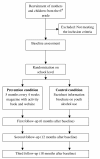Effectiveness of the home-based alcohol prevention program "In control: no alcohol!": study protocol of a randomized controlled trial
- PMID: 21816033
- PMCID: PMC3170247
- DOI: 10.1186/1471-2458-11-622
Effectiveness of the home-based alcohol prevention program "In control: no alcohol!": study protocol of a randomized controlled trial
Abstract
Background: In the Netherlands, children start to drink at an early age; of the Dutch 12-year olds, 40% reports lifetime alcohol use, while 9.7% reports last-month drinking. Starting to drink at an early age puts youth at risk of developing several alcohol-related problems later in life. Recently, a home-based prevention program called "In control: No alcohol!" was developed to delay the age of alcohol onset in children. The main aim of this project is to conduct a Randomized Controlled Trial (RCT) to evaluate the effectiveness of the program.
Methods/design: The prevention program will be tested with an RCT among mothers and their 6 grade primary school children (11-12 years old), randomly assigned to the prevention or control condition. The program consists of five printed magazines and an activity book designed to improve parental alcohol-specific socialization. Parent-child dyads in the control group receive a factsheet information brochure, which is the standard alcohol brochure of the Trimbos Institute (the Netherlands Institute for Mental Health and Addiction).Outcome measures are initiation of alcohol use (have been drinking at least one glass of alcohol), alcohol-specific parenting, susceptibility to drinking alcohol, alcohol expectancies, self-efficacy, and frequency and intensity of child alcohol use. Questionnaires will be administered online on secured Internet webpages, with personal login codes for both mothers and children. Mothers and children in both the experimental and control condition will be surveyed at baseline and after 6, 12, and 18 months (follow-ups).
Discussion: The present study protocol presents the design of an RCT evaluating the effectiveness of the home-based "In control: No alcohol!" program for 6 grade primary school children (11-12 years old). It is hypothesized that children in the prevention condition will be less likely to have their first glass of alcohol, compared to the control condition. When the prevention appears to be effective, it can easily and relatively quickly be implemented as a standard alcohol prevention program on a large scale.
Trial registration: Nederlands Trial Register NTR2564.
Similar articles
-
Family-based prevention programmes for alcohol use in young people.Cochrane Database Syst Rev. 2019 Mar 19;3(3):CD012287. doi: 10.1002/14651858.CD012287.pub2. Cochrane Database Syst Rev. 2019. PMID: 30888061 Free PMC article.
-
Home-based alcohol prevention program for parents and children: A randomized controlled trial.Prev Med. 2016 Jul;88:224-9. doi: 10.1016/j.ypmed.2016.04.018. Epub 2016 Apr 30. Prev Med. 2016. PMID: 27143498 Clinical Trial.
-
Mediation and moderation effects of an in-home family intervention: the "in control: no alcohol!" pilot study.Prev Sci. 2014 Oct;15(5):633-42. doi: 10.1007/s11121-013-0424-4. Prev Sci. 2014. PMID: 23928749 Clinical Trial.
-
Efficacy of smoking prevention program 'Smoke-free Kids': study protocol of a randomized controlled trial.BMC Public Health. 2009 Dec 21;9:477. doi: 10.1186/1471-2458-9-477. BMC Public Health. 2009. PMID: 20025727 Free PMC article. Clinical Trial.
-
[The systematic review of studies on the efficacy of interventions for the primary prevention of alcohol abuse among adolescents].Epidemiol Prev. 1997 Jul-Sep;21(3):180-8. Epidemiol Prev. 1997. PMID: 9424434 Italian.
Cited by
-
Family-based prevention programmes for alcohol use in young people.Cochrane Database Syst Rev. 2019 Mar 19;3(3):CD012287. doi: 10.1002/14651858.CD012287.pub2. Cochrane Database Syst Rev. 2019. PMID: 30888061 Free PMC article.
-
A Systematic Review of School-Based Alcohol and other Drug Prevention Programs.Clin Pract Epidemiol Ment Health. 2015 Feb 26;11(Suppl 1 M6):102-12. doi: 10.2174/1745017901511010102. eCollection 2015. Clin Pract Epidemiol Ment Health. 2015. PMID: 25834630 Free PMC article.
-
What's New in Addiction Prevention in Young People: A Literature Review of the Last Years of Research.Front Psychol. 2017 Jul 6;8:1131. doi: 10.3389/fpsyg.2017.01131. eCollection 2017. Front Psychol. 2017. PMID: 28729846 Free PMC article. Review.
References
-
- Van Dorsselaer S, De Looze M, Vermeulen-Smit E, De Roos S, Verdurmen J, Ter Bogt T, Vollebergh W. Gezondheid, welzijn en opvoeding van jongeren in Nederland. Utrecht: Trimbos Instituut; 2010.
-
- Ellickson PL, Tucker JS, Klein DJ, McGuigan KA. Prospective risk factors for alcohol misuse in late adolescence. J Stud Alcohol. 2001;62:773–782. - PubMed
-
- Kuntsche E, Van der Vorst H, Engels RCME. The earlier the more? Differences in the links between age at first drink and adolescent alcohol use and related problems according to quality of parent-child relationships. J Stud Alcohol. 2009;70:346–354. - PubMed
-
- Bandura A. Social foundations of thought and action: A social cognitive theory. New York: Prentice Hall; 1986.
Publication types
MeSH terms
LinkOut - more resources
Full Text Sources
Medical


